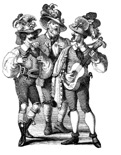
A Schola Cantorum for Today’s Liturgy
RETROSPECT & RATIONALE
In the years after Vatican II, developments in “New Liturgy” brought into common practice liturgical dance, multilingual readings, altar ministries by adult laity, popular musical instruments, contemporary congregational song, missalettes, and above all the concept of the parish as a “faith community.”
Little of that had taken place when in 1976 a group of friends and I founded The Schola Cantorum of the Pacific. Our “cheerful earful” of young adults learned repertory from Palestrina to Peter, Paul and Mary, from Gregorian Chant to Gospel. Our first “cantored” liturgies were in California’s oldest extant church building — Blessed Junipero Serra’s little chapel at mission San Juan Capistrano. In those years, “Music Ministry” was a term our Separated Brethren used. But almost everywhere we’d go, our Schola was welcome. There was a hunger for music in the liturgy. Music was becoming once again primarily congregational. We found ourselves at the dawn of a new era in Church music.
A schola cantorum is a community of singers and musicians who cultivate liturgical music as their principal, and for some groups exclusive, repertory. A member of a schola ideally enters the ensemble as a child and then learns, through apprenticeship, the skills connected with the creation and performance of the music as well as the principles of its usage in liturgy. The apprentice in a schola cantorum learns from the entire performance community rather than from one teacher alone. Schola cantorum means literally “school of singers.” The term dates from at least the time of St. Gregory the Great (who was Pope from A.D. 590 to 604), while the full schola tradition began with the opening of the first public Christian church in Rome, the Lateran Basilica, in A.D. 415. While the focus of a schola is on vocal music, musical instruments until quite recently were also regarded in the Western world as “voices”; from the beginning, instrumental music was also taught in a schola.
While some parishes would retain large choral ensembles, our type of group — a small chamber choir — would become the norm. Eclectic in their cultural and musical background, our members led congregational song in several languages, and did so using that modern musical instrument — the microphone!
Few large choral ensembles would call themselves a schola. And as grassroot groups they would be unable to ply the vocal pedagogy, rich repertory, and liturgical effectiveness of an updated schola cantorum. In fact, twenty centuries of Church music and music education was ironically endangered by the narrow stylistics, ignorance, and amateurishness of the very type of group that would have profited most from the schola tradition — a tradition that was, during most of its history, primarily cantoral, not choral.
You May Also Enjoy
The Church is the mother of Christendom. She encompasses all modes of life, from economy to culture, from politics to family relations.
The lowering of oneself in humility is a statement about the Blessed Sacrament, not about you.
A Carmelite monastery in Wyoming is an exciting new element in the Church in America, and has proven to be fecund ground for vocations to the consecrated life.

